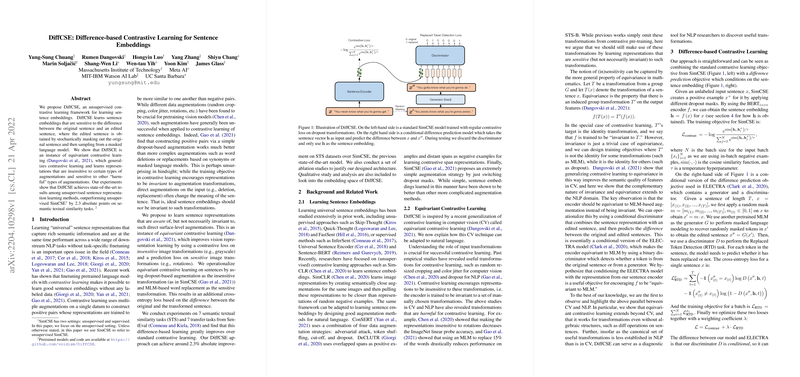Difference-based Contrastive Learning for Sentence Embeddings: An Examination of DiffCSE
The paper "DiffCSE: Difference-based Contrastive Learning for Sentence Embeddings" introduces DiffCSE, an innovative framework for unsupervised learning of sentence embeddings based on contrastive learning approaches. The authors approach this task by leveraging the semantic distinctions between a sentence and its modified counterpart, aiming to address key challenges in sentence representation while advancing the efficacy of text embeddings in NLP applications.
Methodology Overview
DiffCSE stands out due to its focus on sensitive augmentation transformations rather than typical invariant ones. Existing methods, particularly in vision, have underscored the utility of invariant representations when subjected to benign augmentations. However, in text, where semantics can alter with minor edits like word replacement, maintaining sensitivity to such changes is advantageous. DiffCSE capitalizes on this through equivariant contrastive learning, integrating the capacity to distinguish "harmful" augmentations using a binary classification task akin to ELECTRA’s replaced token detection (RTD), which identifies whether a word has been inadvertently altered or artificially generated.
In DiffCSE, the unsupervised framework utilizes stochastic masking and masked LLM (MLM) predictions to transform sentences. The unique addition of a conditional discriminator alongside dropout augmentations enhances the model's understanding of sentence-level semantic nuances, adding depth to the contrastive loss mechanism. This nuanced differentiation allows the model to produce enriched embeddings that capture both invariant and variant characteristics of the data.
Experimental Results and Impact
In empirical evaluations across multiple semantic textual similarity tasks, DiffCSE achieves consistent performance improvements, specifically enhancing state-of-the-art results on STS datasets by an average of 2.3 percentage points over SimCSE. As demonstrated across BERT and RoBERTa implementations, DiffCSE significantly enhances the semantic quality of sentence embeddings, underlining the efficacy of equivariant methods in capturing meaningful textual distinctions.
These results underscore important implications for NLP research, offering new avenues for developing sentence encoders that exhibit both nuanced semantic sensitivity and effective generalization across tasks. The framework proposed by DiffCSE hints at the broader potential of leveraging augmentation awareness in embedding methodologies, suggesting further exploration of transformation-sensitive modeling practices.
Future Directions
Although largely focused on unsupervised scenarios, the paper indicates potential extensions into supervised learning variants, using human-labeled datasets to further refine model performance. This trajectory promises to elucidate more sophisticated strategies for sentence embedding that integrate context-aware learning with advanced segmentation algorithms.
Moreover, DiffCSE's foundational principles could support a wide array of applications beyond text embeddings, applicable to other domains facing similar challenges of maintaining pivotal semantic properties across varied input conditions. An expansion into multimodal settings or domain-specific adaptations could offer significant insights into the dynamics of representation learning.
This comprehensive investigation into DiffCSE reveals the promising terrain that lies ahead for developing robust, nuanced, and adaptive embedding frameworks. By fostering a deeper integration of contrastive learning with linguistic intricacies, the paper makes a compelling case for its broader adoption and continuous refinement within the field.
